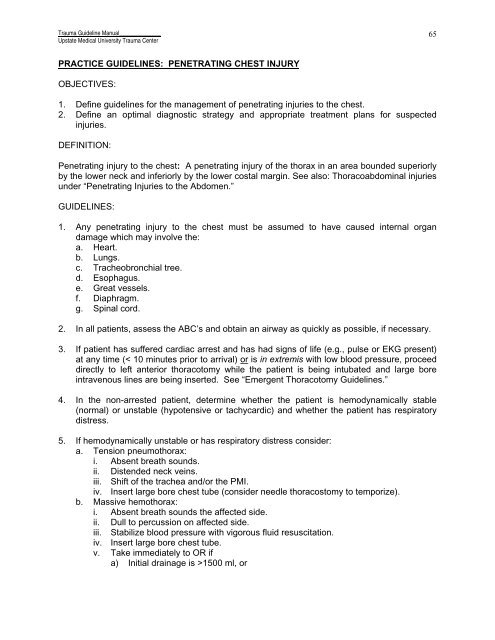Trauma Guideline Manual - SUNY Upstate Medical University
Trauma Guideline Manual - SUNY Upstate Medical University
Trauma Guideline Manual - SUNY Upstate Medical University
You also want an ePaper? Increase the reach of your titles
YUMPU automatically turns print PDFs into web optimized ePapers that Google loves.
<strong>Trauma</strong> <strong>Guideline</strong> <strong>Manual</strong>______________<strong>Upstate</strong> <strong>Medical</strong> <strong>University</strong> <strong>Trauma</strong> Center65PRACTICE GUIDELINES: PENETRATING CHEST INJURYOBJECTIVES:1. Define guidelines for the management of penetrating injuries to the chest.2. Define an optimal diagnostic strategy and appropriate treatment plans for suspectedinjuries.DEFINITION:Penetrating injury to the chest: A penetrating injury of the thorax in an area bounded superiorlyby the lower neck and inferiorly by the lower costal margin. See also: Thoracoabdominal injuriesunder “Penetrating Injuries to the Abdomen.”GUIDELINES:1. Any penetrating injury to the chest must be assumed to have caused internal organdamage which may involve the:a. Heart.b. Lungs.c. Tracheobronchial tree.d. Esophagus.e. Great vessels.f. Diaphragm.g. Spinal cord.2. In all patients, assess the ABC’s and obtain an airway as quickly as possible, if necessary.3. If patient has suffered cardiac arrest and has had signs of life (e.g., pulse or EKG present)at any time (< 10 minutes prior to arrival) or is in extremis with low blood pressure, proceeddirectly to left anterior thoracotomy while the patient is being intubated and large boreintravenous lines are being inserted. See “Emergent Thoracotomy <strong>Guideline</strong>s.”4. In the non-arrested patient, determine whether the patient is hemodynamically stable(normal) or unstable (hypotensive or tachycardic) and whether the patient has respiratorydistress.5. If hemodynamically unstable or has respiratory distress consider:a. Tension pneumothorax:i. Absent breath sounds.ii. Distended neck veins.iii. Shift of the trachea and/or the PMI.iv. Insert large bore chest tube (consider needle thoracostomy to temporize).b. Massive hemothorax:i. Absent breath sounds the affected side.ii. Dull to percussion on affected side.iii. Stabilize blood pressure with vigorous fluid resuscitation.iv. Insert large bore chest tube.v. Take immediately to OR ifa) Initial drainage is >1500 ml, or
















